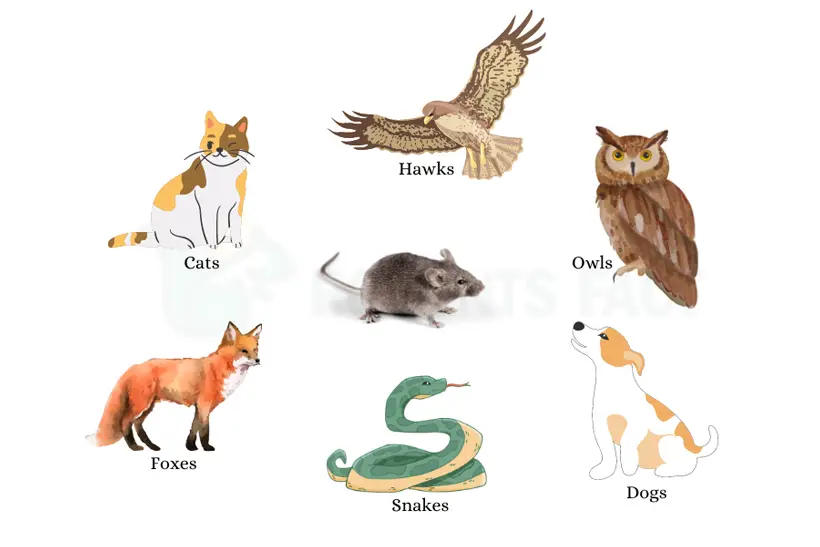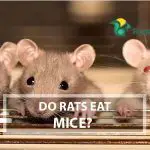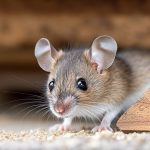What Eats a Mice: A List of Predators and Raptors
Mice infestation is a common problem in every household. And we try various methods to control their population. Do you know that nature also helps us in this matter? We see many birds and animals survive by eating mice.
So, what eats mice? The prominent mice eaters can be categorized into two main segments: raptors and terrestrial predators. The raptors include hawks, owls, etc. And the predators are foxes, cats, snakes, dogs, etc.
In this article, you are about to know the mice eating context in detail while understanding its significance. So keep reading!
In-depth Exploration of What Eats A Mice
There are two main categories of mouse eaters: raptors and predators. We detail each one in this section.

1. Raptors
In this mice-eater category, we include hawks and owls.
Hawks
By natural rule, hawks prefer fresh meat to a dead animal’s meat. This basic characteristic of this bird leads to the inclusion of mice in the diet list. Also, there are two reasons associated with this mouse-eating habit.
- First, mice offer a rich source of nutrients.
- And second, hawks can catch mice in a relatively easier way in comparison to catching other species. Hawks use the swoop method to catch mice.
They soar in the sky or sit on tree branches. As soon as the bird locates mice, it swoops to the surface, catching them. Finally, an adult hawk can eat 6-8 mice a day.
Check out this YouTube video to learn more about hawks hunting mice:
Owls
Owls hunt and consume a wide variety of creatures. And mice hold a prominent place in their diet. They use their binocular vision power of forward-facing easy and acute hearing capability to locate a mouse at night. Once detected, the owl swoops down silently and swiftly.
Also, they use specialized feathers to reduce noise during the flight. Lastly, after capturing a mouse, owls typically swallow it whole. You should know that an owl can eat up to twelve mice in one night.

2. Predators
Here, we detail the context of mice eaten by foxes, cats, dogs, and snakes.
Foxes
Among the diverse prey of foxes, mice are a common diet for them. Foxes thrive in a wide range of environments, including forests, grasslands, urban areas, etc.

And these places are highly suitable habitats for mice. The easy availability of a large number of mice in the mentioned places makes the mice a hot favorite food for foxes. When hunting mice, foxes use their excellent hearing to pinpoint the rodents’ movements.
Foxes even reach the underground nest of mice by digging the borrowing swiftly.
Cats
Even though most of the cats are now domesticated, they have not lost their natural hunting instincts. When cats encounter mice, their inhabiting natural predator instincts kick in their psychology, directing them to kill and eat the mice. To kill the mice, cats go for an ambushing strategy.

They wait a long time with patience before making a final approach to the mice. They crouch down and slowly reduce the distance to catch every enemy. Then, they pounce on the mice in a swift and coordinated movement.
Interestingly, sometimes cats display a playful attitude during their mouse-hunting activities.
Dogs
Well, eating mice is not healthy for domesticated dogs, and you rarely see a dog eating a mouse. In general, wild dogs eat mice to satisfy their hunger. But, in this case, eating mice is mostly the last option.

Also, dogs are not as skilled in catching mice as cats or foxes. However, dogs use their sense of smell and hearing to detect mice’s presence and use their sharp claws to immobilize a mouse. Finally, they eat the mouse alive.
Snakes
Mice are the most common prey for many snake species. To hunt mice, snakes use their keen senses of smell and heat detection. By having Jacobson’s Organ and heat-sensing pits, snakes develop a thermal image of their surroundings and locate the presence of warm-blooded prey like mice.

Once they capture a small mammal, the snake begins the process of swallowing the mouse whole by using its flexible jaw and muscular body contractions.
Eating Mice: Ecological Contribution of Predators and Raptors

Below are the ecological contributions of predators and raptors in terms of eating mice.
- Mice are prolific breeders. It means that their populations can explode very quickly. By eating mice, predators and raptors control the mouse population.
- Mice serve as an important food source for raptors and predators.
- Eating mice by these animals and birds assists humans in pest control.
- Mice eaten by predators assist in maintaining the natural energy flow chain.
Is It Okay If My Pet Eats A Mice?
It is a natural thing that cats and dogs eat mice. But, if domesticated cats and dogs eat mice, it is a serious concern for you as their diet is now very different and controlled in comparison to the wild ones.
Mice eventually carry roundworms, Toxoplasma gondii, etc. After eating mice, your pet dog or cat can get infected by these parasites, receiving degraded health conditions.

FAQs
Now that you know the animals that eat mice, let’s look into some of the most common questions.
Q: Do humans eat mice?
Yes, humans can eat mice. This tiny creature is a good source of protein and micronutrients. And people, especially indigenous people, eat mice on a daily basis.
Q: Do mice eat mice?
Yes, mice eat other mice. If the mice are hungry and there is a dead mouse, the living one will eat the dead mice. This happens in the winter when food availability is very limited.
Q: Can mice eat themselves?
If the mice are in an extreme food crisis, they can eat their body parts. It is a distinct form of cannibalism. In this case, mice eat their own tails.
Final Words
We hope that now you know the detailed information about what eats mice. Owls, hawks, snakes, foxes, cats, dogs, etc., hunt and eat mice to meet the food requirement. In this case, domesticated dogs are less likely to eat mice.
However, mice consumption by predators serves multiple critical purposes. This includes population control, biodiversity maintenance, and natural pest regulation. The interactions between mice and the mentioned predators symbolize the natural balance and interdependence of all living organisms within an ecosystem.




